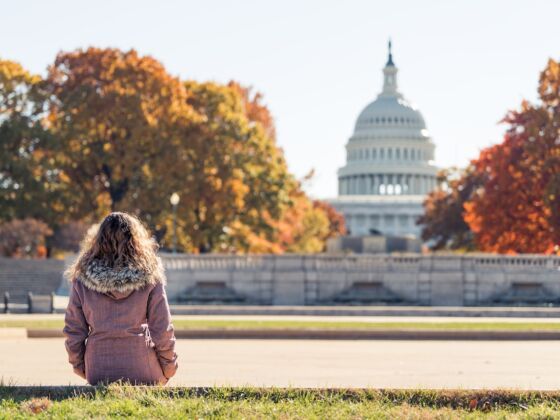When you think of the nation’s capital, low carbon footprint and green living don’t exactly come to mind, especially when you find yourself sitting in traffic for hours on the I-495 beltway. However, Cooking Light magazine recently ranked Washington, D.C. third on its top 20 healthiest U.S. cities list. The city was evaluated on its abundance of organic markets, expanse of green space for an urban area, and its pedestrian-friendly atmosphere.


Green Guide to Washington, D.C.
Practical Information
By air, you’ll probably arrive into one of DC’s two major airports – Ronald Reagan Washington National Airport (DCA), or Washington Dulles International Airport (IAD). From DCA for just $1.65 one way, the city center is a short 15 minute subway ride directly from the airport. From IAD, a $9.00 bus pass on the Washington Flyer coach bus drops you off at the Metro West Falls Church subway station in about 30 minutes or the cheaper Metrobus takes you directly to L’Enfant Plaza station for just $3.00
If entering the district by train, all Amtrak, MARC and VRE commuter trains arrive into Washington, D.C.’s Union Station. From there, you can connect with its metro rail system and ride around the city. By bus, the Greyhound Bus Terminal sits directly behind Union Station on the Metrorail’s Red Line. Washington, D.C. boasts one of the cleanest and most accessible subway systems in the country and also covers significant areas within its neighboring states of Maryland and Virginia.
Landmarks
Washington, D.C. is renown world-wide for its wealth of museums per square area from the instantly recognizable Washington Monument to the Smithsonian Institute with its slew of free museums. The landscape is dotted with history-laden memorials such as the Lincoln Memorial, Jefferson Memorial, National World War II Memorial, Korean War Veterans Memorial, and Vietnam Veterans Memorial, most within walking distance from each other if you’re up for the task or at the very least metro accessible.
Arts and Culture
There is no shortage of things to do in Washington, D.C. and the Washington Post maintains an extensive Arts and Culture guide to the city.
Markets
From the freshest fruits and vegetables to other home-made organic products, you’re sure to find what you need in one of Washington, D.C.’s numerous farmers’ markets. The famous Eastern Market, located on 7th St. between C St. and North Carolina Ave is the only 19th century market in the region still operating today. In addition to a farmers’ market which is open on Saturdays and Sundays, it hosts a flea market and an arts and crafts market. Other area markets include FreshFarm markets which organizes markets in neighborhoods such as Dupont Circle, Foggy Bottom, and Penn Quarter with over 30 farmers providing fresh bread, poultry, prosciutto, cheeses, and pies in addition to produce. Be sure to check out About.com’s comprehensive listing of Washington D.C area markets.
Green Space
Known as American’s Front Yard, and an instantly recognizable sight in movies such as Forrest Gump, the National Mall is a large city center park which links various monuments and connects key government buildings. On any day, rain or shine, you can find residents jogging or simply enjoying an outdoor lunch in the park. There are many other green spaces and trails around the District. The enormous Rock Creek Park, twice the size of New York’s Central Park, Potomac Park, as well as Anacostia Park which boasts recreational opportunities such as boating provide solace from the urban jungle. Also located in DC, is the United States National Arboretum, a major center for botanical research with a wide assortment of flora and trees.
Eats
It’s no secret that the nation’s capital is a cultural melting pot of influences from all over the world. From neighborhoods such as Chinatown to Dupont Circle, a bad meal in D.C. is pretty hard to come by. However, there are a couple eats going the extra mile. Cashion’s Eat Place located in the famous Adams Morgan district provides a slew of scrumptious, organic dishes. Restaurant Nora is an upscale restaurant and was the first to be certified organic in the country. Hook located in Georgetown provides seafood and other local organic produce. The wildly popular and eco-friendly hotspot, Java Green, is setting a great example by using wind power to offset its carbon footprint, using biodegradable products, and supporting small farmers by participating in fair trade. VegDC, touted as the vegetation guide to Washington, D.C. provides a listing of restaurants and organizations.
Sleep
Green TravelHub provides a list of “green” hotels in the D.C area from the low end Days Inn to the pricier Fairmont Hotel, all doing their part to conserve energy and water using efficient lighting, low flow showers and toilets, and actively recycling. For the budget conscious traveler, the American Guest House, a Bed and Breakfast located in Dupont Circle provides quaint rooms and complimentary hot breakfast serve daily. The Kalorama Guest House is a bed and breakfast with two locations: a Victorian townhouse in Adams Morgan, and a location in Woodley Park On the high end, Hotel Palomar located in Dupont Circle is an eco-friendly boutique hotel that recycles, provides organic beverages, using soy-based ink, uses energy efficient bulbs, and uses low flow systems in an effort to conserve water and reduce its environmental impact.
Other Information
Green Festival held every year in the District and other cities around the country is a way for environmentally conscious organizations and individuals to trade ideas, network, and build the promote lifestyle. Other great resources include National Geographic’s Green Guide and GridSkipper’s Your Eco-Friendly Guide to the District.